
The Zimmerman House is a historic home located at Columbia, South Carolina, United States. It was built in 1848, and consists of a 1+1⁄2-story main section and a one-story wing. The front façade features a Greek Revival style pedimented portico supported by two paneled wooden square columns. The house was built by Charles and Hannah Zimmerman, who operated the neighboring Zimmerman School from 1848 to 1870.
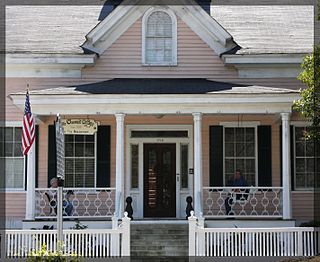
Chesnut Cottage is a historic home located at Columbia, South Carolina. It was built between 1855 and 1860, and is a 1+1⁄2-story, Classical Revival style frame house, with a central dormer with an arched window. It features projecting front portico with octagonal columns and ironwork and wood balustrade. It was the home of General James Chesnut, Jr. and Mary Boykin Chesnut during the American Civil War period. In the fall of 1864, President Jefferson Davis was entertained at the home and made a speech from the front steps of the portico.

Horry-Guignard House is a historic home located at Columbia, South Carolina. It was built before 1813, and is a two-story, late Federal style, modified I-house type frame dwelling. The front facade features a one-story, full-width balustraded porch supported by square columns. During the winter of 1813–1814, the main hall was widened from six feet to eleven feet. To do this, the house was sawed in half and the two ends were pulled apart to rest on two new foundations. It was probably built by Peter Horry (1747-1815), a Revolutionary War Colonel and Brigadier General of the South Carolina Militia. Later, the house was acquired by John Gabriel Guignard (1751-1822), the Surveyor General of South Carolina from 1798 to 1802. Guignard is responsible for the early design of the city and laid out the first streets of Columbia.

Preston C. Lorick House, also known as the Lorick-Baker House, is a historic home located at Columbia, South Carolina. It was built before 1840, and remodeled in the late 1800s in the Late Victorian style. It is a two-story, frame dwelling, with a wraparound portico. The house features decorative brackets under all eaves and gingerbread woodwork. It was the home of Governor John Lawrence Manning during his term of office from 1852 to 1854.
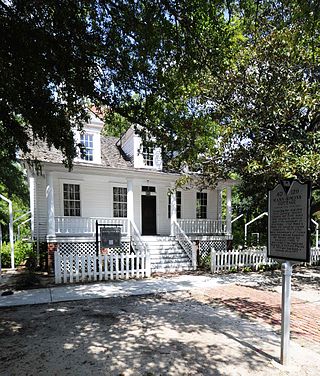
Mann-Simons Cottage is a historic home located at Columbia, South Carolina. It was built around 1850, and is a 1+1⁄2-story, cottage style frame house on a raised basement. The front façade features a porch supported by four Tuscan order columns. It was the antebellum home of a substantial free black Columbia family.

McCord House, also known as the McCord-Oxner House, is a historic home located at Columbia, South Carolina. It was built in 1849, and is a 1½-story clapboard Greek Revival style cottage, with additions made in the 1850s. It sits on a stuccoed raised basement. The front facade features a one-story portico supported by four stuccoed piers. It was built by David James McCord (1797–1855), a planter, lawyer, and editor, and his wife Louisa Susannah Cheves McCord, a noted author of political and economic essays, poetry, and drama. In 1865, the McCord House became the headquarters of General Oliver O. Howard, who was General William Tecumseh Sherman’s second in command. It was added to the National Register of Historic Places in 1979. The house is currently owned by Henry McMaster, the incumbent Governor of South Carolina, who purchased the property in May 2016.

Ensor-Keenan House is a historic home located at Columbia, South Carolina. It built about 1870, and is a 1+1⁄2-story, Italianate style frame dwelling. It features a central projecting pavilion with a steeply pitched hipped roof and full width front porch. It was the home of Dr. Joshua Fulton Ensor, second medical superintendent of the State Asylum.

W. B. Smith Whaley House, also known as the Dunbar Funeral Home, is a historic home located at Columbia, South Carolina, United States. It built in 1892–1893, and is a three-story, irregular plan, Queen Anne style frame dwelling. It features a corner turret with conical roof and a long curving enclosed front porch. It was built by W. B. Smith Whaley, president of the Columbia Electric Street Railway and Mill Stable Company. In 1924, it became the Dunbar Funeral Home.
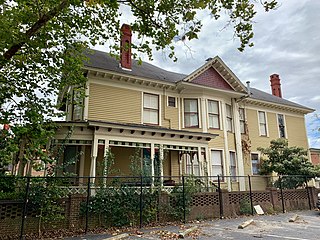
Moore-Mann House is a historic home located at Columbia, South Carolina. It built about 1903, and is a 2+1⁄2-story, irregular plan, Queen Anne style frame dwelling. It features a one-story verandah, bay windows, decorative shingles and an arched entrance. It was designed by W. B. Smith Whaley, Co., a prominent Columbia architectural and engineering firm, whose owner also built the W. B. Smith Whaley House.

Lyles-Gudmundson House is a historic landmark home located in Columbia, South Carolina. It was built between 1918 and 1922, and is a two-story Classical Revival style brick dwelling. The home was a wedding gift for Evelyn Robertson Lyles, the daughter of Edwin Wales Robertson. A banker who is credited with much of Columbia's early twentieth century development, Robertson commissioned New York City architect James Brite to design his daughter's home as part of his Wales Garden neighborhood. Brite - a native North Carolinian who died in 1942 - was also the architect of The Braes in Glen Cove, New York and the famous Darlington Mansion near Mahwah, New Jersey.

Heslep House is a historic home located at Columbia, South Carolina. It built about 1927, and is a two-story Spanish Mission Revival style stuccoed house. It features round-headed windows, arches, balconies, sun decks, a square tower, sculptural portal and barrel tile roof.
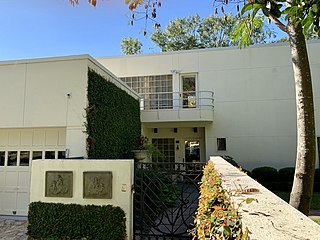
Wallace-McGee House is a historic home located at Columbia, South Carolina. It built in 1937, and is a two-story International style stuccoed house. It features large areas of glass, a flat roof and a steel and reinforced concrete structural system. The front façade features a two-car garage topped by a sun deck. The house is based on plans by Edward Durell Stone published in Collier's Magazine on March 28, 1936.

Taylor House, also known as the former home of the Columbia Museum of Art, is a historic home located in Columbia, South Carolina. It was designed by the architectural firm of Andrews, Jaques & Rantoul and built in 1908, as a two-story, L-shaped, brick Neo-Classical style mansion. The front facade features a projecting portico supported by large, fluted limestone Corinthian order columns. It was built for Thomas Taylor, Jr., who served as president of Taylor Manufacturing Company.

Fair-Rutherford and Rutherford Houses, refers to a set of two historic homes located at Columbia, South Carolina. The Fair-Rutherford House was built about 1850, and underwent three alterations during the following century. It was demolished in 2004. The two-story Rutherford House was built in 1924–25. They are associated with they prominent African American Rutherford family of Columbia. The Rutherford House presently serves as an office for Palmetto Dental Services. It was added to the National Register of Historic Places in 1984.

George R. Price House is a historic home located at Columbia, South Carolina. It was built in 1939, and is a two-story, L-shaped, steel-framed, masonry dwelling in the Streamline Moderne style. It has a flat roof, glass block windows, multiple porches, and a three-car garage.

Raymond Price House is a historic home located at Columbia, South Carolina. It was built in 1952, and is a two-story, L-shaped, steel-framed, masonry dwelling in the Streamline Moderne / International style. It has a flat roof and front and rear balconies. Also on the property is a one-story structure that is now an office.
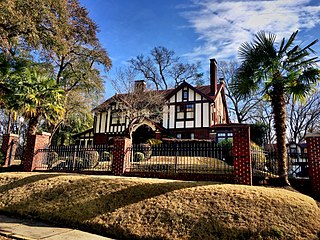
A. Fletcher Spigner House, also known as the Spigner-Wilson-Seibels House and Hanner House, is a historic home located at Columbia, South Carolina. It was built in 1920, and is a 2+1⁄2-story double-pile, rectangular frame residence in the Tudor Revival style. It has a one-story, central front portico, a red terra cotta tile roof, and faux half-timbering with a finish of stucco on the second floor. Also on the property is a 1+1⁄2-story garage. It was built for A. Fletcher Spigner, a prominent Columbia attorney, State Senator, and South Carolina's Fifth Circuit Solicitor.

Building at 303 Saluda Avenue, also known as John C. Heslep House, is a historic home located at Columbia, South Carolina. It was built about 1917 as a two-story brick residence, then remodeled and rebuilt in the Spanish Colonial Revival style in 1927–1928. It features a low-pitched tile roof, coarse stucco walls, and cast iron balconies. Also on the property is a contributing guest house.

Harriet M. Cornwell Tourist House is a historic tourist home for African-American patrons located at Columbia, South Carolina. It was built about 1895, and is a two-story, frame American Foursquare style dwelling. It has a hipped roof and features a one-story wraparound porch. Mrs. Cornwell began operating her house as a tourist home during the 1940s.
McCollum-Murray House, also known as the C. E. Murray House, is a historic home located at Greeleyville, Williamsburg County, South Carolina. Built c. 1906, the house was the home of African-American educator Dr. Charles Edward Murray, and is an example of transitional folk Victorian and Classical Revival residential architecture. It was originally a two-story, T-shaped dwelling. It features a wraparound one-story porch. It has a single-story rear gabled addition, with another single-story shed-roofed addition built in the 1950s.























